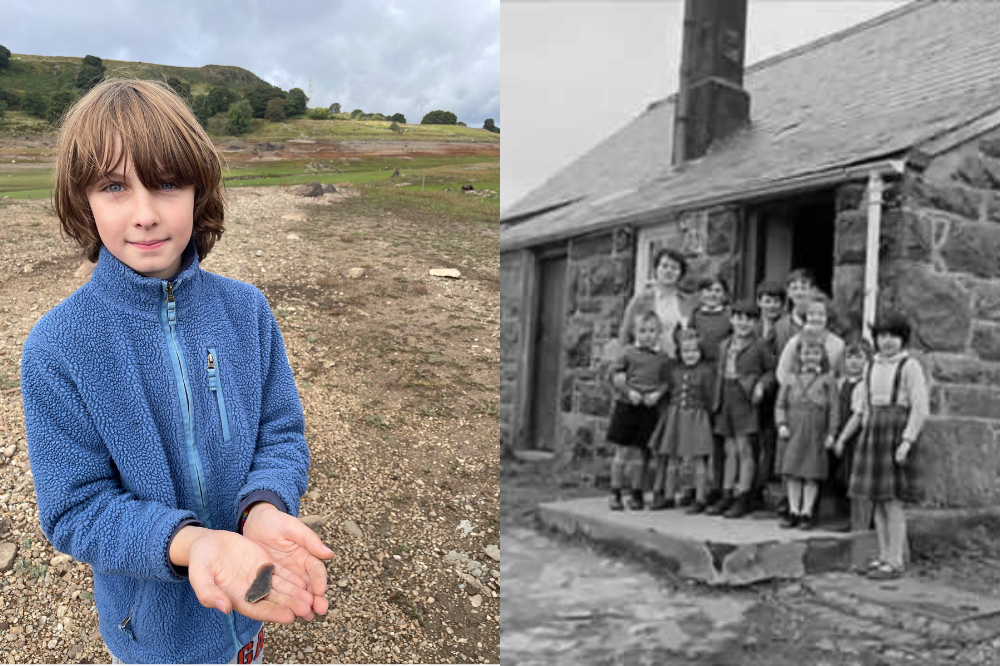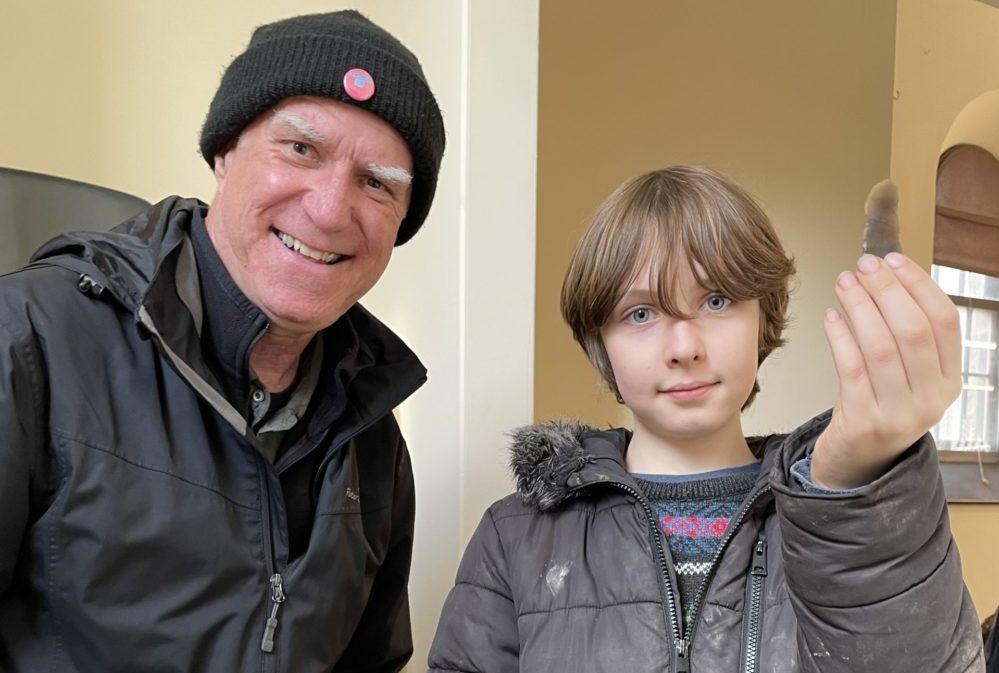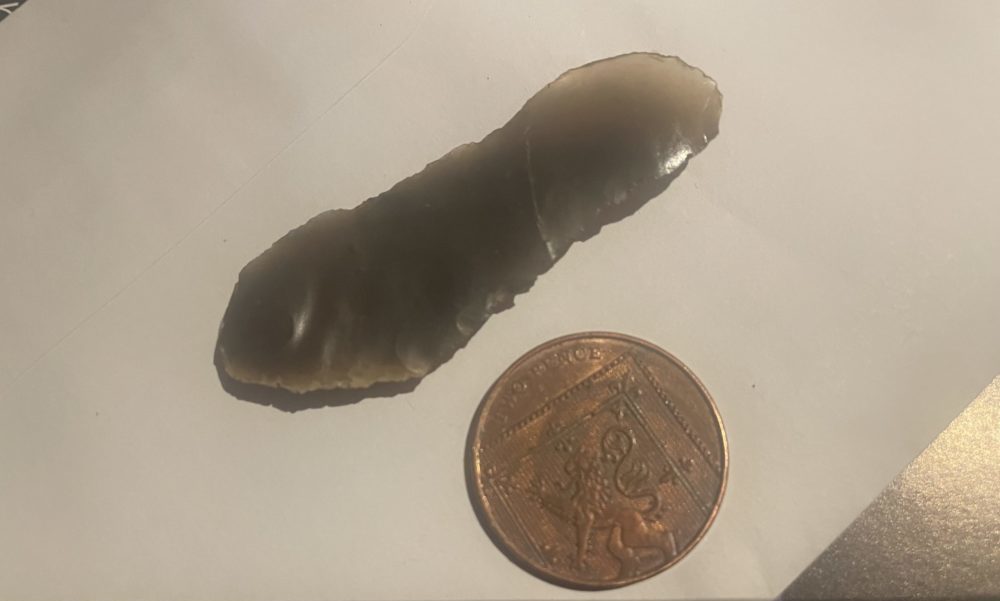Revisited: Child finds ancient artefact on the bed of drought-hit Llyn Celyn

Stephen Price
An 11 year old budding archaeologist has discovered a mesolithic flint blade on the site of one of Wales’ most important historical sites thanks to last year’s dry summer and autumn.
Capel Celyn near Bala in north Wales is notoriously associated with one of the most important moments in modern Welsh history – the eviction of its inhabitants to create a reservoir to supply Liverpool with water in the face of widespread national opposition.
The moment proved pivotal in galvanising the calls that would eventually lead to the formation of Wales’s Senedd.
In that year, 1965, Alderman Frank Cain, Chairman of the Liverpool Water Committee, pulled a lever and buried the valley, the community and its history under 68 million tonnes of water.
Dry summer
Last year’s dry summer, with much lower-than-average rainfall, led to a serious drought across north Wales and famously revealed the main road and remnants of Capel Celyn’s chapel, with people from all over Wales making pilgrimages to the site.
11 year old Elfyn Wyn, a pupil at Ysgol Pen Barras, Rhuthun and member of Wales Young Archaeologists Club (YAC) was one such visitor.
Elfyn’s story
Elfyn told Nation.Cymru: “It was October when we went, so the rain was definitely going to come back and cover Capel Celyn once more. My Dad drove me there, I might be an adult the next time we get to go back!
“We wanted to see and do as much as possible. We sang at the chapel, walked down Celyn’s main road and climbed some of the village’s small hills.
“We could hear the Tryweryn, further up from the village, running along its old river bed, so we followed this. Old farming fields looked like something from another planet.
Walking through the past
Elfyn walked alongside stone wall boundaries of former fields intermingled with hedgerow stumps still bearing the chainsaw marks of the Liverpool Water Corporation contractors.
On the summit, resting on natural rock, Elfyn Wyn found a knapped Mesolithic flint blade and knew there and then, thanks to his membership of Young Archaeologists Club, that flint isn’t to be found naturally in Wales.
He knew that the flint he held would have had to have been carried there by human hands long ago.
Rhys Mwyn
This year, Elfyn contacted archaeologist and Radio Cymru presenter Rhys Mwyn, who immediately recognised the flint as being a small blade from the Neolithic or even as far back as the Mesolithic.

Mesolithic finds, found across North Wales, suggest a population that that followed water routes, particularly along the Dee Valley. Branching along the Tryweryn into the uplands would have presented many opportunities.
Flint carried by our Neolothic and Mesolithic ancestors were often in the form of projectile points and scrapers. Flint knives however are particularly special as they were used in daily life to cut up meat and other foodstuffs and also in preparing animal skins for use as leather and chord.
During the Mesolithic age, the climate in Wales became warmer and wetter than it is today. This led to changes in the vegetation, with the development of a wooded landscape inhabited by Mesolithic hunter-gatherers.
The diet included fish, wild boar and other animals such as elk, red deer, roe deer and aurochs (wild cattle).

Even with future droughts, hope of finding ancient postholes and evidence of dwellings, might have alluded archaeologists forever with much of Capel Celyn’s topsoil compromised or washed away.
Flint artefacts are found from time to time across Wales. However, there are no registered finds from the flooded Tryweryn valley floor on the National Museum of Wales’ ‘Portable Antiquities Scheme’.
David Howell, Public Relations at the National Museum of Wales said of the find: “While a blade such as this is small, it stands out as a really interesting example of the archaeology in the area.
“Small tools like this are strong indicators of human activity being a consistent feature of the Capel Celyn area for thousands of years”
Support our Nation today
For the price of a cup of coffee a month you can help us create an independent, not-for-profit, national news service for the people of Wales, by the people of Wales.





Alongside spitting at peaceful protestors walking the streets of Liverpool, a Capel Celyn resident questioned a water official on the claim that the scheme was essential to provide drinking water for Liverpool. With a smirk the official replied that our water was only good enough for them to flush their toilets.
Cofiwch Dryweryn. Cofiwch Cymru!
My nain was a Capel celyn resident she was a child at the time of the the flooding roedd y teulu I gyd yn mor happus I symud allan , dim pres dim gwres dim byd, you need to look deeper , yes Liverpool flooded the village but the residents were happy to go …
I had family there also, but regardless of who wanted to stay or move, this was an eviction forced by authorities from another country under false pretenses. The money Liverpool made from selling on the water could have paid for new houses, but some ended up in a caravan!
Cofiwch yr anghyfiawnder!